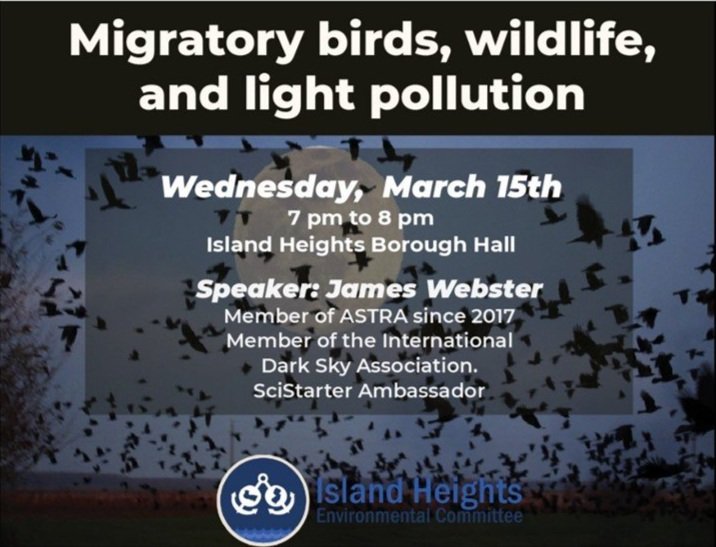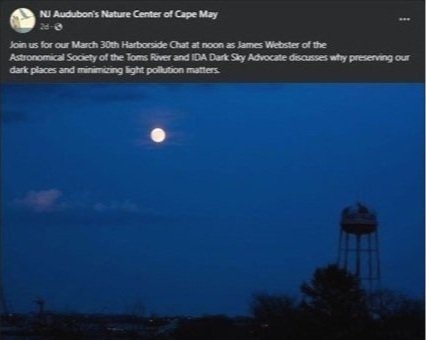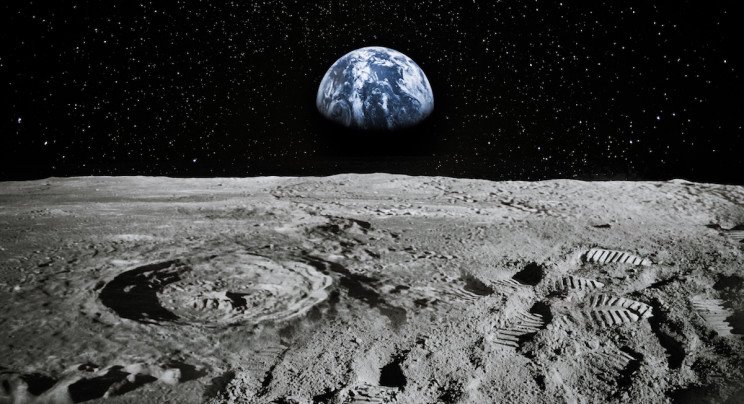Astral Projections Online April 2023
Check our Website for updated content at www.astra-nj.com
Club Presentations Wanted:
Does anyone have any astronomy items of interest to share with the membership?
Please let us know at Club Contacts.
Club dues and membership. If you renew after March 31 you will be renewed as a new member.
ASTRAL PROJECTIONS ONLINE (APO for short) is an email-linked publication for members only. If you exit APO to the club website or other resources you will need to use the emailed link again to get back to it. If you wish to retain a copy please bookmark or refer back to the email. We will make all efforts to post by the first week of the month.
Submissions Welcome: Members are invited to submit articles, photos, news, or stories for inclusion with Astral Projections Online. Please contact the ASTRA Webmaster.
Event Calendar
ASTRA’s next meeting will be Friday, April 14, 2023, at 7 PM EST. This will be an in-person meeting at Novins Planetarium - Building 13.
EVENT Cancellations: Members will receive email notifications of an event cancellation.
April ASTRA Meeting
We will have a telescope workshop for our April meeting. We will be outside assisting members and the public with telescopes, as long as the weather cooperates with us. While inside having a discussion on telescopes and accessories.
EXPO - NEAF 2023 - Rockland Community College - 145 College Rd, Suffern, NY - April 15 - 8:30 AM (All Day)
Public - Jakes Branch Star Party - April 22 - 8:30 PM
Public - Jakes Branch Star Party - May 13 - 9 PM
Public - Jakes Branch Star Party - June 10 - 9 PM
Public - IBSP Solar Observing - June 24 - Pending Approval
Upcoming County Park Presentations 2023
Public Outreach Presentations, if any member wishes to support ASTRA outreach efforts with the public, please let Vinny, Ro, or Jim know of any interest.
County Park presentations require a registration fee, call the hosting park to reserve.
Cattus Island Nature Festival - April 29 - 9 AM (All Day Event) - Free Event - Pre-planning get-together afternoon on April 23.
Island Beach State Park Ocean Fun Day - May 20 - 11 AM to 3 PM - Free Event - Pending confirmation - This event will be similar to Cattus Island Nature Festival. One table with display and solar telescope if clear.
Website Updates …
Please visit our club website. We continue to have additional updates, if there is some content that would be useful to members please let us know.
"Equipped, with his five senses, man explorers the universe around him and calls the adventure Science.”
- Edwin Hubble, Astronomer
Event Reports
March 15, 2023 - Jim Webster had an International Dark Sky Association meeting with the Island Heights Environmental committee. This meeting had a good showing from the Island Heights community. After some local technical difficulties, the meeting went well with community participation with plenty of questions.
March 23, 2023 - ASTRA members were invited to attend remotely a presentation about Edward Emerson Barnard, hosted by the Ford Astronomy Club from Dearborn, MI. Our participation was low, I believe from the short notice we had and as one member put it, Thursdays are for “robot fightin'.” But we did have members attending via Webex.
Edwin Emerson Barnard was an American astronomer that was recognized as a gifted observational astronomer. Best known for his discovery of the proper motion of Barnard’s Star in 1916, which was named for him.
For more on Edward Emerson Barnard:
Wikipedia, Sonoma State University,
25-page PDF from Nasaonline.org
March 25, 2023 - Jakes Branch Star Party, was canceled due to weather.
March ASTRA Meeting Summary
Irish Astronomers
Our March presentation followed our expected Irish presentation as we’ve had in previous March meetings. ASTRA member Bob Salvatore presented Irish Astronomers and as expected was informative and entertaining. We had a good showing for this meeting and I think everyone totally enjoyed it.
It was also nice to see Leviathan making another appearance at one of our meetings again. Always enjoy seeing this one as it is a favorite of your APO Editor.
Our Nearest Neighbor
Let’s explore some interesting features, facts, or myths about our nearest neighbor, the Moon. Without it, life on Earth would be totally different, if not at all.
Japanese astronomer catches meteorite smashing into the moon
A Japanese astronomer captured the telltale flash of a meteorite impacting the moon, causing a brief flash on our celestial neighbor's nightside.
Japanese astronomer Daichi Fujii captured this shot of a meteorite impacting the moon (bright flash at the bottom left) on Feb. 23, 2023. (Image credit: Daichi Fujii (Hiratsuka City Museum))
Crater Abulfeda
Crater Abulfeda is named after the Syrian prince, geographer, astronomer, and historian, Ismail Abul-Fida (1273-1331). Note: Astronomy.com Moon cards have him listed as a Syrian prince, but other resources have him as Kurdish.
A lunar impact crater located in the central highlands of the Moon. To the northeast is the crater Descartes, and to the south-southeast is Almanon. To the north is the crater Dollond. A chain of craters named the Catena Abulfeda runs between the southern rim of Abulfeda and the north rim of Almanon, then continues for a length of 210 kilometers across the Rupes Altai.
Catena Abulfeda, crater chain, is the best-known feature of its type on the Moon. It consists of a linear string of 20 impact craters ranging in size from 1 to 3 km in diameter. The largest, Almanon C, is positioned near the middle of the chain.
Upcoming Cattus Island Nature Festival - Getting Closer
The time is near for the Cattus Island Nature Festival at the end of April on April 29. We will be presenting our interest in astronomy as well as the problems with light pollution. If the weather is good we’ll have some solar observations.
We are looking good for volunteers,
If anyone else wishes to join us please let Jim Webster know.
All of it is not just manning our display, everyone gets time to participate in other events if they wish.
Having member participation in these kinds of events that we only do a few of, helps get the word out about ASTRA and maybe increase the membership. Over the past two years, we’ve been getting more exposure and hopefully, this has been helping.
For everyone that will be helping we’ll also have a repeat of the pre-event get-together on April 23 at 12 PM. This will give us an opportunity to review what we’ll be doing and have a good time doing so. Pizza, snacks, etc, etc …
Scistarter a citizen science hub of over 3,000 programs will be joining us with a table of their own, that will have a Scistarter representative and some Verizon employees working the event.
Jim Webster will also be providing two presentations at the Cooper Nature Center this year during the Nature Festival. Solar Astronomy and Scistarter Earth Science.
Outreach material below is distributed free for public outreach.
Around The Web
The Cat’s Eye Nebula
Facts about the Cat's Eye Nebula and how to observe and photograph it from Earth.
On the lighter side of astronomy …
Members Submitted Articles & Items
Whatever it is, the way you tell your story online can make all the difference.
March was a busy month with Light Pollution



March was a busy month in getting information out to the public about the problems with light pollution. Jim Webster International Dark Sky Advocate had three presentations this month including a radio show interview. Dark Sky presentations were with the Island Heights and Brick Township Environmental Committees. The Cape May Audubon Nature Center followed by a radio show interview at Cape May 101.5.
Additional activity now includes a monthly committee meeting with some township council members from North Jersey as well as the Sierra Club via Zoom, which are crafting some legislature to combat light pollution.
For more go to NASA Jet Propulsion Laboratory webpage: What’s Up: Skywatching Tips From NASA
This article and images are distributed by NASA Night Sky Network
The Night Sky Network program supports astronomy clubs across the USA dedicated to astronomy outreach.
Visit nightsky.jpl.nasa.gov to find local clubs, events, and more!
Solar Eclipses Are Coming!
By David Prosper
Have you ever witnessed a total solar eclipse? What about an annular solar eclipse? If not, then you are in luck if you live in North America: the next twelve months will see two solar eclipses darken the skies for observers in the continental United States, Mexico, and Canada!
Solar eclipse fans get a chance to witness an annular eclipse this fall. On Saturday, October 14, 2023, the Moon will move exactly in front of the Sun from the point of view of observers along a narrow strip of land stretching across the United States from Oregon to Texas and continuing to Central and South America. Since the Moon will be at its furthest point in its orbit from Earth at that time (known as apogee), it will not completely block the Sun; instead, a dramatic “ring” effect will be seen as the bright edge of the Sun will be visible around the black silhouette of the Moon. The distinct appearance of this style of eclipse is why it is called an annular eclipse, as annular means ring-like. If you are standing under a tree or behind a screen you will see thousands of ring-like shadows projected everywhere during maximum eclipse, and the light may take on a wan note, but it will not actually get dark outside; it will be similar to the brightness of a cloudy day. This eclipse must only be observed with properly certified eclipse glasses, or other safe observation methods like pinhole projection or shielded solar telescopes. Even during the peak of the eclipse, the tiny bit of the Sun seen via the “ring” can damage your retinas and even blind you.
Photos of an annular total solar eclipse (left) and a total solar eclipse (right). Note that the annular eclipse is shown with a dark background, as it is only safe to view with protection – you can see how a small portion of the Sun is still visible as the ring around the Moon. On the right, you can see the Sun’s wispy corona, visible only during totality itself, when the Moon completely – or totally - hides the Sun from view. A total solar eclipse is only safe to view without protection during totality itself; it is absolutely necessary to protect your eyes throughout the rest of the eclipse! Credits: Left, Annular Eclipse: Stefan Seip (Oct 3, 2005). Right, Total Eclipse, NASA/Aubrey Gemignani (August 21, 2017)
Just six months later, a dramatic total solar eclipse will darken the skies from Mexico to northeast Canada, casting its shadow across the USA in a strip approximately 124 miles (200 km) wide, on Monday, April 8, 2024. While protection must be worn to safely observe most of this eclipse, it is not needed to witness totality itself, the brief amount of time when the Moon blocks the entire surface of the Sun from view. And if you try to view totality through your eclipse viewer, you will not actually be able to see anything! The Moon’s shadow will dramatically darken the skies into something resembling early evening, confusing animals, and delighting human observers. You will even be able to see bright stars and planets - provided you are able to take your eyes off the majesty of the total eclipse! While the darkness and accompanying chilly breeze will be a thrill, the most spectacular observation of all will be the Sun’s magnificent corona! Totality is the only time you can observe the corona, which is the beautiful outer fringes of the Sun’s atmosphere. For observers in the middle of the path, they will get to experience the deepest portion of the eclipse, which will last over four minutes - twice as long as 2017’s total solar eclipse over North America.
This detailed solar eclipse map shows the paths of where and when the Moon’s shadow will cross the USA for the upcoming 2023 annular solar eclipse and 2024 total solar eclipse, made using data compiled from multiple NASA missions. Where will you be? This map is very detailed, so if you would like to download a larger copy of the image, you can do so and find out more about its features at: https://svs.gsfc.nasa.gov/5073 Credits: NASA/Scientific Visualization Studio/Michala Garrison; eclipse calculations by Ernie Wright, NASA Goddard Space Flight Center.
While some folks may be lucky enough to witness both eclipses in full – especially the residents of San Antonio, Texas, whose city lies at the crossroads of both paths – everyone off the paths of a maximum eclipse can still catch sight of beautiful partial eclipses if the skies are clear. The Eclipse Ambassadors program is recruiting volunteers across the USA to prepare communities off the central paths in advance of this amazing cosmic ballet. Find more information and apply to share the excitement at eclipseambassadors.org. NASA has published a fantastic Solar Eclipse Safety Guide which can help you plan your viewing at bit.ly/nasaeclipsesafety. And you can find a large collection of solar eclipse resources, activities, visualizations, photos, and more from NASA at solarsystem.nasa.gov/eclipses
Sun activity: Even quieter sun
At the time this APO was being put together the Sun has since quieted down. We recently had a big CME hit that created auroras all the way down to New Mexico. A massive eruption of solar material, known as a coronal mass ejection or CME, was detected escaping from the sun at 11:36 p.m. EDT on March 12, 2023.
Check out EarthSky and PHYS.ORG for more.
Let’s Explore Space - What’s in the Sky April 2023.
Sombrero Galaxy - M104
The Sombrero Galaxy is a peculiar galaxy of unclear classification in the constellation borders of Virgo and Corvus, being about 9.55 megaparsecs from the Milky Way galaxy. It is a member of the Virgo II Group, a series of galaxies and galaxy clusters strung out from the southern edge of the Virgo Supercluster. Wikipedia
Radius: 25,000 light-years
Apparent mass: ~0.0000008 billion M☉
Distance to Earth: 29.35 million light-years
Age: 13.25 billion years
Magnitude: 8
Stars: 100 billion
Coordinates: RA 12h 39m 59s | Dec -11° 37′ 23″
Through 7x50 or 10x50 binoculars, M104 is visible under dark skies as a small round patch of nebulosity. The galaxy is easy to observe with almost any telescope. A 100mm (4-inch) scope under good seeing conditions hints at dark markings within the structure. When seen through larger 200mm (8-inch) reflectors, M104 appears as a flattened saucer with a large center bulge bisected by the dark dust lane.
Visit the STScI which produces Hubblesite.org video overviews for Tonight’s Sky.
They can be found both on Facebook and stsci.edu.
Submissions Welcome
Members are invited to submit articles, photos, news, or stories for inclusion with Astral Projections Online. Please contact the ASTRA Webmaster.

























